Discover all comprehensive guide to the magical towns and villages in Puglia – Italy’s southern pearl.
Located in the heel of Italy’s boot, Puglia is a stunning region of Italy, famous for its hobbit-like trulli, incredible coastline and turquoise seas, delicious food and beautiful rural landscapes. For those planning a holiday in Puglia, take a look at our A to Z guide to all the many towns and villages that should be on your bucket list. Look forward to tips on visiting this stunning corner of southern Italy along with our favourite things to do in Puglia.
Alberobello
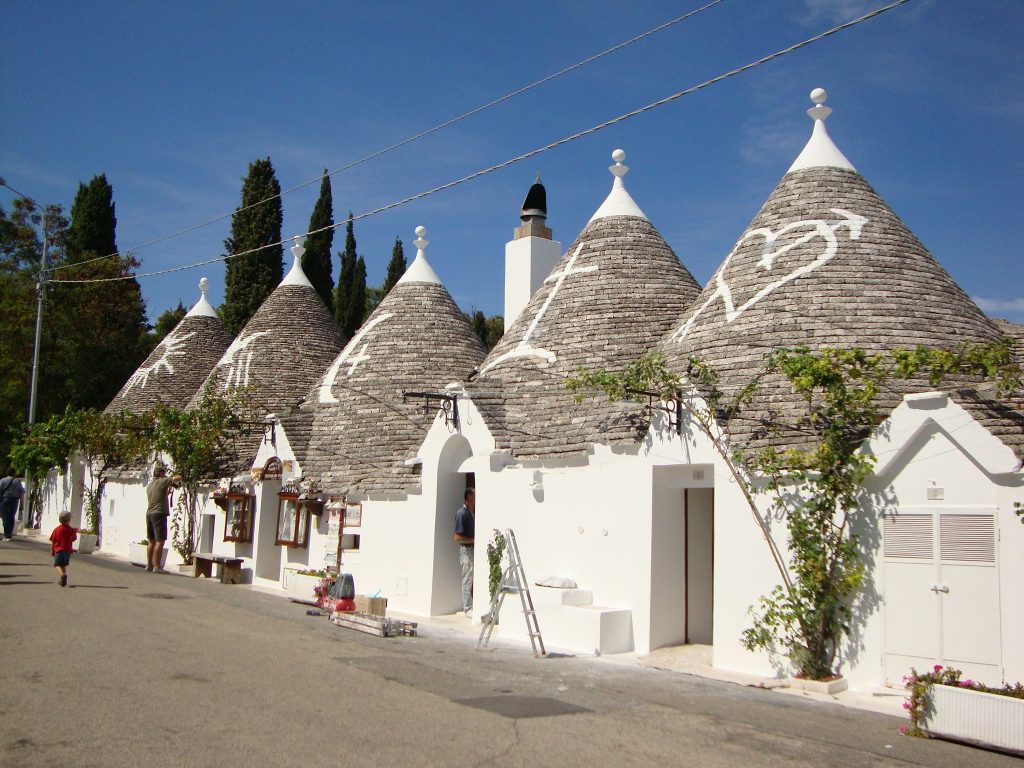
Perhaps Puglia’s most famous town, Alberobello is a UNESCO world heritage site, boasting 1400 trulli dating back to the 1400s. The town is divided into two main parts – Monti and Aia Piccola. You can spend hours exploring it’s narrow, winding streets as you make your way to the Trullo Sovrano. This is the largest trullo, boasting two floors internally and a winding staircase. To learn more about the history of the trulli, visit the Museo del Territorio, with exhibits and tools on display explaining how people used to live.
It’s easy to get to, situated almost bang in the middle of the triangle marked by Brindisi, Bari and Taranto. Beware though – as a UNESCO World Heritage site it can get quite busy in summer season, but if you visit earlier in the morning or later in the afternoon you can avoid any crowds and explore at your own pace. The busiest part of Alberobello is Rione Monti, a sloped district facing the modern town centre. Here there are many street vendors selling all kinds of trullo related gifts.
Many of the trulli are now souvenir shops but you will find restaurants within their walls too whilst many are private homes or B&B establishments. Even the town’s cathedral is a trullo! The trulli themselves date back to the 16th century and are built directly on to the rock, without any foundations and without use of any mortar. The idea back then was to build houses that could be easily dismantled. In this way, the ruling Counts of Conversano could avoid taxation on new urban settlements that had been imposed by the King of Naples. This design of building also had the added bonus of allowing them to easily destroy the homes of recalcitrant villagers. The town is divided into 2 parts – Rione Monte and Rione Aia Piccola. The former is comprised of narrow streets gently sloping upwards and featuring around 1000 trulli scattered along 7 parallel streets culminating at the top with the Chiesa Sant’ Antonio, a trullo-shaped church, whilst the latter is much less commercialised district of about 600 trulli, still occupied.
The busiest part of Alberobello is Monti, home to Rione Monti. Here you’ll find plenty street vendors selling plenty of trullo related gifts and souvenirs as well as shops selling local crafts and foodstuffs. It can get very busy during the Summer months, with coachloads of tourists dropped off each morning. We therefore recommend you head to the town either early in the morning or last thing in the day, or alternatively, if can’t avoid being there in peak hours, you may want to head to the Aia Piccoli to escape the crowds. Slightly further from the modern centre of Alberobello, you’ll find that Aia Piccola is more residential, less visited and therefore potentially more authentic. Booking a local guide can also help you get the most out of your visit. Book yours in advance here.
Another way to avoid the crowds is to actually stay there, allowing you to be there before they arrive and after they have left! This holiday rental in Alberobello is the perfect base for you next holiday in Puglia. Or discover our full collection of stunning villas in Alberolbello here.
Alezio
Alezio sits to the East of Gallipoli and is a classical Baroque centre. It is also famous for the wine produced here – Alezio Riserva, Alezio Rosato and Alezio Rosso – produced from the Negromaro grape.
Often overlooked in favour of its coastal neighbours, Alezio rewards curious travellers with archaeological treasures, quiet streets, and genuine Salento hospitality. The towns history traces back to the ancient Messapian civilization so it has much to offer vistors lookig=nf for a an authetic window into this era of history.
Altamura
Altamura is a delightful place to visit characterized by narrow streets and small street facing courtyards called ‘claustri.’ It is also home to the only cathedral built by Emperor Frederick II – the Cathedral of Santa Maria Assunta. However the town is most famous for being home to the Altamura Man, the fossil remains of a man who lived between 250,000 and 400,000 years ago and who visitors can see in the National Archaeological Museum.
Bari
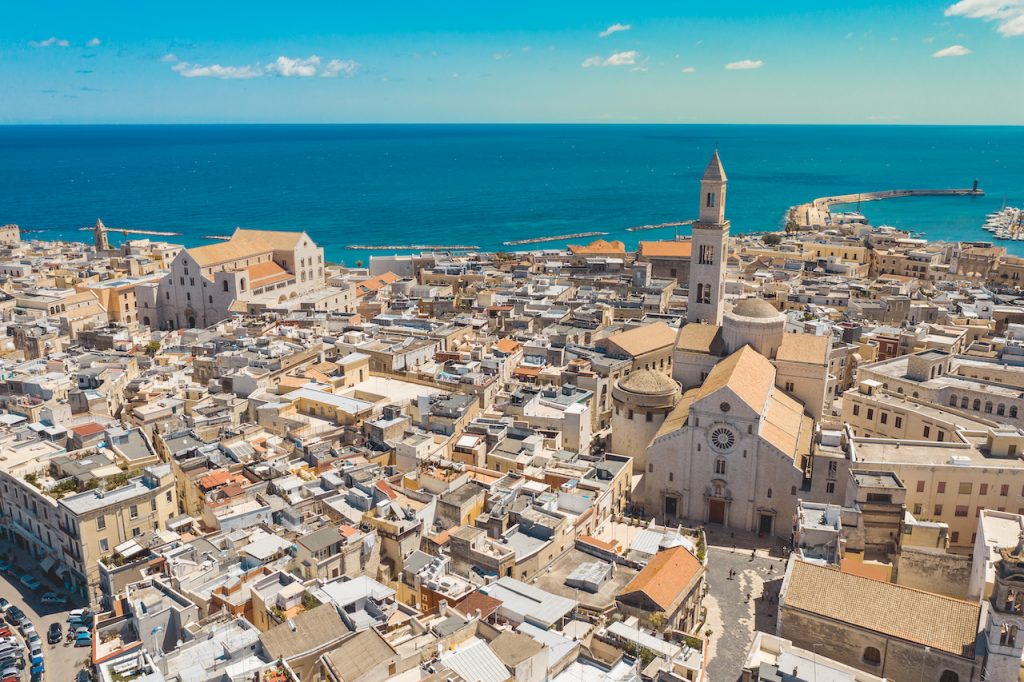
Bari is Puglia’s capital city and can claim to have the longest seafront of any Italian town or city. It boasts a fascinating history, first coming into prominence under the Romans who made it into one of the most important trading towns on the Adriatic. After the fall of the Roman Empire, it continued to play a prominent role as a trading centre, becoming inextricably linked to the Eastern Mediterranean as the town’s port became central to the slave trade. It then went on to become a crucial departure point for the Crusades. Even today, it remains the busiest passenger port in the Adriatic, with regular ferry links to the Balkans and Greece.
Bari is often called the Bologna of southern Italy. A cosmopolitan, vibrant city, it manages to combine the youth of its population with the culture and traditions Italy is famous for. The city’s youth culture is largely down to its university. The effect of this ripples across the rest of the city and there are some fantastic bars, clubs and restaurants to be enjoyed. It’s also fantastic for and seafood lovers, with thousands of local fishermen selling their daily catch to the eateries across the city.
Visitors should spend time wandering through the old town, from the Basilica to the Cathedral of San Sabino, an area filled with convents, churches, small shops and bakeries. We love taking a stroll in the early morning when the noisier night spots around Piazza Farrarese and Piazza Mercantile are closed. On your morning stroll, don’t be surprised to come across old ladies sitting on the street by their front doors, kneading pasta, forming the local pasta ‘ orecchiette’ – and leaving them to dry on their wooden frames.
There are a number of buildings worth visiting. These include the Castello Svevo which has a rich and varied history. It was originally constructed by the Norman King Ruggero II but was partially destroyed in 1156 by the people of Bari who were tired of the constant struggle and rebellion. However it was restored by Frederick who, in the process, softened it and lessened its previous austerity. By 1500, under Isabella of Aragon it morphed into a Renaissance residence with a court that welcomed artists, writers, dignitaries and humanists. Also worth a visit is the Cathedral of San Sabino. This is one of the best examples of Romanesque architecture in Puglia.
The city boasts a number of museums worth visiting as well including the Archaeological Museum of Santa Scolastica (MUSASS), the Diocesan Museum and the Museo Nicolaiano. For those with children, the Casa di Pulcinella might be a better choice to visit. This museum will tell the history and stories of puppets and marionettes. And last but not least, there is the Art Gallery Corrado Giaquinto, where visitors will enjoy the opportunity to view examples of traditional Pugliese art as well as paintings by Vivarini, Tintoreeto, Paolo Finoglio and Luca Giordano.
Whilst these museums will satisfy the appetite of any historian, there is just as much to offer music lovers too. After all, Bari is home to the Teatro Petruzzelli which is the fourth largest opera house in Italy and the largest private theatre in Europe. The original theatre dated back to the 19th century but the building was almost completely destroyed by fire in 1991, to be re-opened 18 years later in 2009 after years of careful and painstaking restoration work. Situated on the Corso Cavour in the heart of Bari Murattiana, over the years it has hosted a range of international artists from Rudolf Nureyev to Frank Sinatra and from Luciano Pavaroti to Ray Charles.
But before you think you have discovered all that Bari has to offer, don’t miss what is literally under your feet! If you have time, it’s possible to enjoy an underground archeological tour of Bari. The tour lasts around 90 minutes and takes you from the Castello Svevo (Norman Castle) across the old town. Led by accredited archeologists, it’s a superb way to learn about the history of the city, from the first bronze age settlement to the Roman era and then the glorious Byzantine Empire.
Read our full Bari Guide here. And discover our luxury villas in the region here.
Bitonto
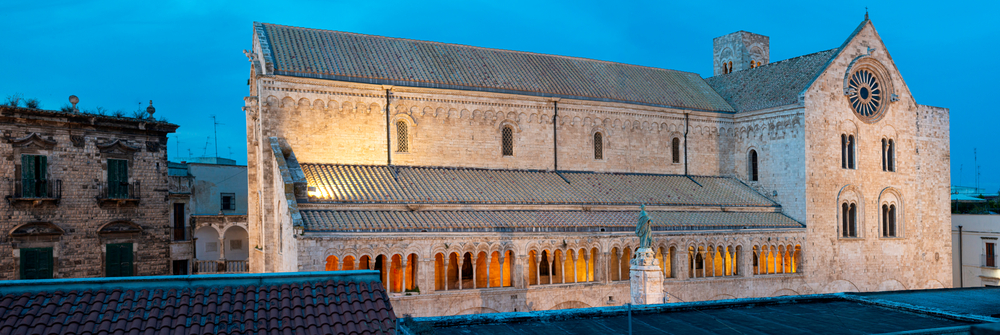
Well known for its olive oil, Bitonto is surrounded by olive groves and rolling countryside. However it’s also got an impressive range of museums and archaeological sites, making it perhaps a less well known “must” when in Puglia.
Bitonto Cathedral is a fine example of Apulian Romanesque style. Recent excavations around the cathedral have uncovered remains of 11th century churches and chapels. A famous mosaic depicting the “Grifo”, or “Snout”, is visible in its atrium. There are numerous other churches too, including the Church of San Gaetano built in 1609, the Church of the Crusafix and the Monastery of Saint Leo.
The old centre is full of charming, narrow streets which you can lose yourself in for a few hours. Why not pick up a coffee and ice cream at one of the little cafes and just watch the world go by for a bit!
Brindisi
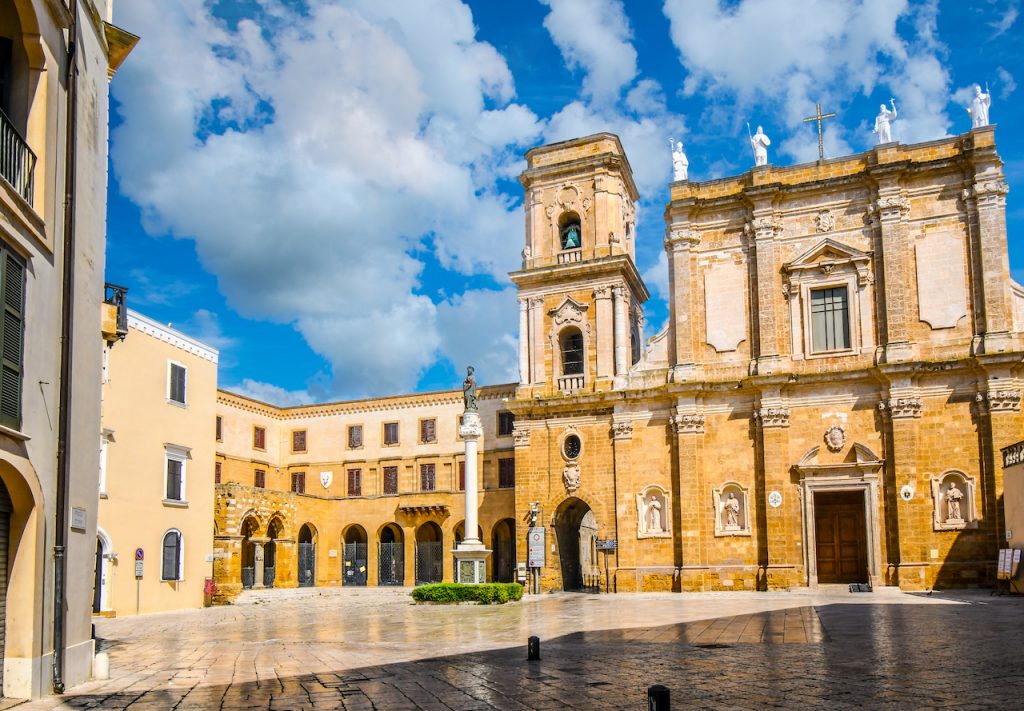
Brindisi is a world away from Bari. It has a much slower pace of life and is probably more typical of the villages surrounding it than other big Italian cities. You’re more likely to find locals sat outside playing chess, than partying all night long. Whilst many holidaymakers may fly into Brindisi, or may use Brindisi’s port to take them to Greece and the Balkans, fewer actually take the time to stop and visit the city. And yet, there is plenty to see and do here.
Unfortunately, in its most recent history, Brindisi was badly damaged by bombing during the Second World War and, as a result, has spent much of the last fifty years rebuilding. However, the city is finally beginning to reap the rewards of this makeover. It now has an inviting seafront promenade lined with bars and restaurants and it’s centre is characterized by wide tree-lined avenues and some beautiful churches, not least the city’s cathedral.
A couple of very important historic attractions also survived the bombing of WWII and are worth visiting. Brindisi boasts not just one but two castles – the Castello Alfonsio on St Andrea Islands and the Castello Svevo. The fist was built in 1445 and served as a military base for the garrisons. The latter was built earlier by Frederick II in 1227 as a fortified residence and was then expanded at the end of the 1400s by Ferdinand of Aragon. More recently, the castle served as a prison in the 1800s and from 1909 onwards it has been the base for the Italian Royal Navy.
If you’re visiting Brindisi, then take the time to head just out of town to Santa Maria del Casale where you will be rewarded with a beautiful rural church dating back to the 12th century. It’s interior is frescoed with the ‘Last Judgement’ dating back to the 1300s and is a delight for any art historian.
Also worth a visit is the Museo Archeologico Provinciale Ribezzo. It covers several floors and houses around 3000 bronze sculptures in Hellenestic Greek style. It’s also where they’ve stored, and displayed, terracotta figurines from the 7th century as well as various other finds from the Roman era.
Carovigno
Whilst food is important throughout Puglia (and arguably most of Italy), Carovigno is certainly an important stopping point if you are a food lover as it is home to a number of internationally acclaimed restaurants. It is also an important centre for olive oil production.
Like many of the towns in Puglia, Carovigno’s buildings are similarly whitewashed in contrast to its central caramel-coloured castle – Dentice de Frasso – that stands in the centre. The town has a long history, dating back to the Massapic period before the Roman times but much of what remains today date back to the Middle Ages including this castle. Initially called the Castello Orsini-Balzi which defended the town against the Turks, the castle passed through many hands and many families until becoming the seat of the Dentice de Frasso. The building is impressive with three imposing towers, thick walls and a chapel dedicated to Saint Anna.
These aren’t the only towers in the town. The city boasts 14 towers in total around the city walls. The most notable of these include the Torretta del Civile, Porta Brindisi and Porta Ostuni. Carovigno’s narrow alleyways and palaces date to a similar period of history. Take time to stroll around them, exploring what the city has to offer.
If visiting around Easter time, look to see if you can watch the spectacle of the ‘Nzegna’. Dating back over 1000 years, this is a highly skilled pageantry display involving flag throwing accompanies by the beating of drums and the sounding of trumpets.
This luxury villa in Puglia is just a short drive from Carovigno or this 5 bedroom Puglia villa is within walking distance from the centre of Carovigno. Or discover our full collection of villas in the area here.
Castellana Grotte
Found under your feet, the caves at Castellana are not to be missed. A labyrinth of caves and caverns 3 km long and lying 70 metres underground, it’s an incredibly beautiful spectacle which will delight young and old alike. As soon as you enter the cave, you will head down a staircase to the grave, in the middle of which sits a giant Cyclops stalagmite. From here, you will pass through the Corridoio del Deserto, which leads to the Sala delle Grandi Cortine and the Grotta Bianca, the brightest cavity in the world. If visiting in July and August, why not take advantage of the chance to take an evening tour – the Speleonight. Or at certain times of the year, you can even watch ‘Hell in the cave’. For those visiting with children, combine the trip underground with a visit to the adjacent dinosaur park or to the Museo Speleologico Spinelli where you will be able to look up at the stars and planets through the observatory telescope.
Please note that it’s worth checking the official website before you go. Entry times are set and the tours are in set languages dependent on the tour time so to be sure you may the visit best suited to you, check times in advance.
Castellaneta
Further up the coast from Gallipoli and slightly inland is Castellaneta, a pretty town perched on the Gravina Grande, one of the most spectacular canyons in Puglia. The town’s most famous resident was Rudolf Valentino, one of the greatest stars of the silent movie era. There is a museum dedicted to him in the town.
Ceglie Messapica
Important for foodies, Ceglie Messapica is also one of the oldest towns in Puglia dating back to the 15th century BC and, as a result, has a very different look and feel to many of the other towns and villages nearby. Many of the buildings have almost a Moorish look about them and there are plenty of interesting churches and buildings to admire.
A good time to visit is in September when the town hosts the Giovedi Settembre, the primary purpose of which is to drain the ‘old’ barrels of wine in order to make room for the new harvest that is just around the corner. Not surprisingly therefore, the festival involves plenty of food, drinking and dancing!
This trullo in Puglia is just a few minutes from Ceglie Messapica and is an idyllic place to stay.
Cheradi Islands
The Cheradi islands lie in the Gulf of Taranto, accessible from Taranto. The largest of the islands (and accessible to visitors) is Isola di San Pietro. Visitors who head to the island will be able to enjoy time on wonderfully secluded beaches or can enjoy a walk in the forests and woodland, dominated by pine trees, oaks, plane and palm trees. Wildlife is in abundance and includes kingfishers, turtle doves in the air and starfish and sea urchins under water.
Cisternino
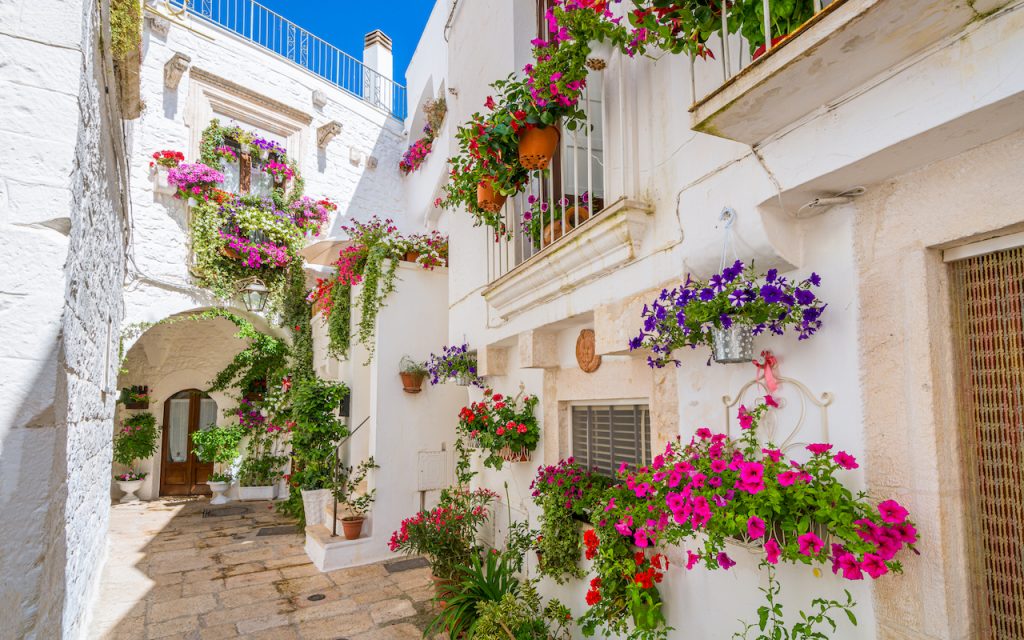
Cisternino is on the list of the ‘Borghi piu belli d’Italia and it’s easy to see why. Whitewashed houses and narrow streets create a stunning backdrop to the balconies of flowers. It’s truly unspoilt and home to a number of architectural gems including the 13th century Norman-Swabian tower, the Palazzo Amati and the Church of San Cataldo.
To get a taste for the town’s food heritage, visit one of the hot stoves attached to the butcheries and enjoy the legendary bombette, simple slices of veal stuffed with cheese, rolled and skewered on a spit.
Try and coincide your visit with one of the many festivals that take place in Cisterino. These kick off in May each year with the Festival of the gnummredd which is a type of local sausage whilst in August, these include the Festa di San Quirico and the Sagra della Bombetta e Bruschetta which brings together two great foodtuffs. There are also festivals dedicated to Puglia’s famous ear-shaped pasta – orecchiette. Also across July and August is the Aperitivo Classico, when every Sunday morning live classical music accompanies the aperitivo ritual.
Fasano
The flat plains of Fasano teem with olive groves and are now home to a number of luxury spa resorts and golf courses. However, take a climb up the Selva and you will be able to enjoy the cool of the oaks and chestnuts.
Fasano is also home to one of the most popular family destinations in Puglia – the Zoo Safari. The largest wildlife park in Italy, visitors will have the chance to take a jeep ride to safely observe the wildest of animals including tigers, lions, giraffes and gorillas. Not only that but a train will take you round the waterfalls and pools where you can spot hippos, seals and bears. And there is much, much more to explore on foot too. The safari park and zoo covers 140 hectares in total and is home to around 1000 species. Not only that but you can also enjoy a number of adrenalin filled rides here too including the Rapid River and Sputnik, a high speed experience featuring a 30 metre tall tower which is certainly not for the feint hearted!
For a bit more culture, visit the Tempietto di Seppannibale just outside Fasano. Dating back to the early Middle ages, the building is of great architectural value.
Foggia
Foggia has a long history but much of the city was destroyed in recent years either by earthquakes or by bombing during WWII. The 13th century cathedral has survived though. There is much to explore underground here though. Visitors can enjoy a trip below ground to its fascinating urban hypogea.
Galatina
A real hidden gem, Galatina has a largely Baroque centre set within 16th century walls and gates (Porta Nuova, Porta Luce and Porta Cappuccini). It can boast many noteworthy buildings including the Church of St Catherine, home to some beautiful frescoes by Francesco d’Arezzo, the Palazzo del Concerto, the Palazzo Scrimeri, the Church of Santa Maria della Grazia, the Chiesa del Carmin and the Chiesa di San Paolo. The latter is famous for its supposed curative waters which is said to cure those who have been bitten by the tarantula spider. On a sweeter note, it is also where Puglia’s most delicious cake – the pasticciotto – was invented.
Gallopoli
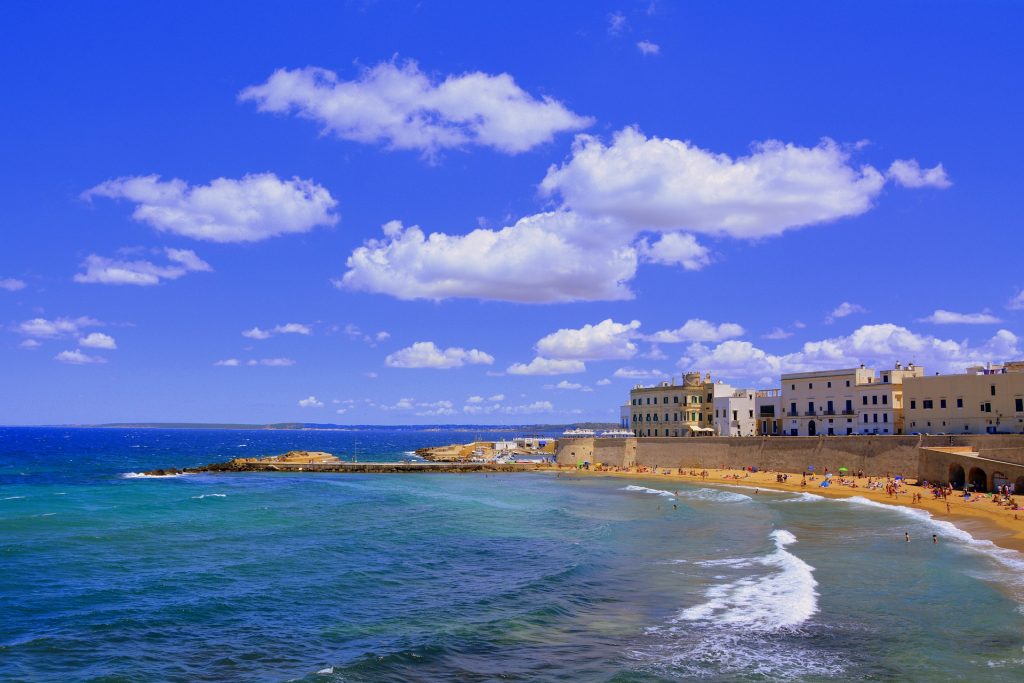
Around the heel of Italy on the other side of the coast is Gallipoli. This is divided into the ‘borgo’ which is the more modern part and the old city. The centro storico is located on a small island just off the coast, linked to the mainland by a 16th century brudge. Once part of Greater Greece, by the 18th century, Gallipoli had become a thriving commercial centre famous for its lamp oil that was exported throughout the Mediterranean and Northern Europe. As well as being used to light lamps including the lights in London, the oil was also made into soap including the famous Savon de Marseille.
Translated literally, Gallipoli means ‘beautiful city’ in Greek and it certainly has much to admire in its centro storico (old quarter). Nowadays, Gallipoli is very much a young and fashionable destination, epitomized by white sandy beaches and busy beach bars along the Spiaggia della Purita. But the town has something to offer all ages.
The old centre of town sits on an island connected to the mainland by a bridge and remains surrounded by defensive walls to this day. The Castello Angioino di Gallipoli stands proudly here. Whilst it was originally constructed in the 13th century, much of what stands today originates in the 15th century when extensive repairs and reconstruction was carried out. Some of the other attractions not to be missed certainly include the Cattedrale di Sant ‘Agata which has a beautifully intricate façade as well as the underground oil press.
Gargano
By far our favourite destination if you’re wanting to be by the coast is the Gargano promontory. In fact, this has to be one of the most beautiful areas in Italy. The landscape is simply stunning with white limestone cliffs overlooking bright blue seas contrasting with the dense forests and lush green meadows filled with colourful flowers. The Umbra Forest that lies within the promontory covers an area of over 15,000 hectares and is now protected as a national park. It is home to over 2000 species of plants and for keen botanists, it’s an opportunity to enjoy the highest concentration of wild orchids in the whole of Europe. It’s also a paradise for walkers and cyclists with plenty of paths and tracks for everyone to enjoy. We suggest you pick up a map of the trails and paths from the Villagio Umbra. This is the visitor centre and museum located in the middle of the forest. But don’t just stay inland…. make sure you also visit the coastline here too. It’s just as spectacular and is dotted with gorges, caverns and caves. A couple of the prettiest towns along this stretch of coastline are Vieste and Peschici. Inbetween these two towns you will be able to spot the ‘trabucchi’ which are ancient fishing traps consisting of a wooden platform set on stilts over the sea on which sits a series of poles, ropes and winches and on which nets are hung.
Giovinazzo
Just 20 kilometres from the busy city of Bari lies Giovinazzo, a much sleepier coastal town with a picturesque and colourful port. Whilst there is not a great deal to see here, it’s a lovely spot to enjoy a passeggiata. For those interested in history, a visit here can be combined with a trip to the Dolmen of Saint Sylvester, an example of megalithic architecture dating back to the Bronze Age.
Isole Tremiti
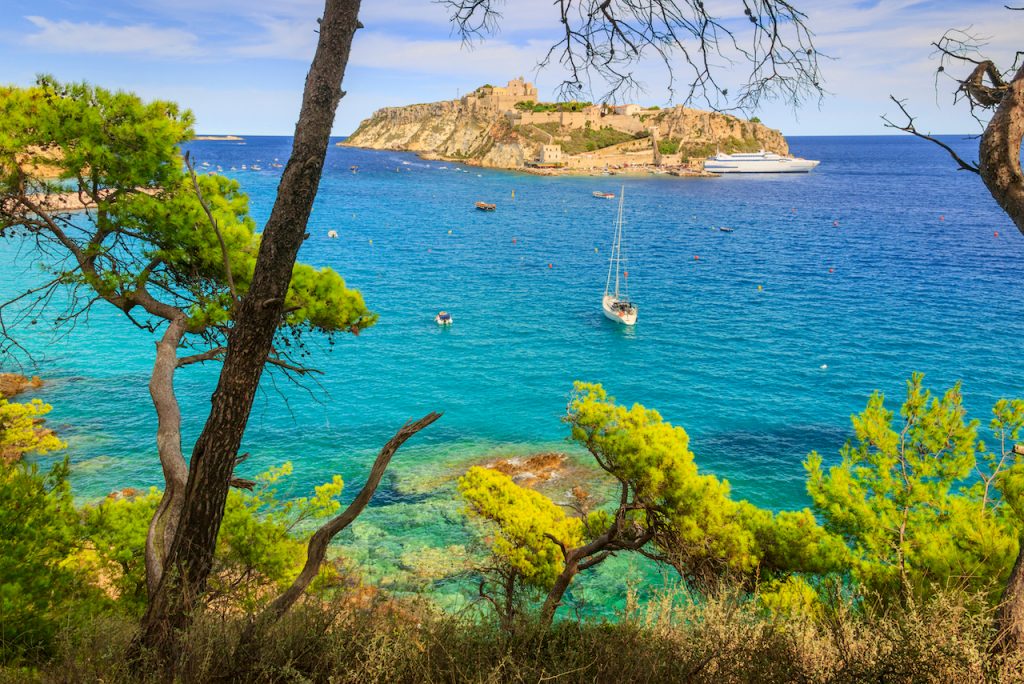
Situated off Gargano’s coastline, this is a group of islands known for its incredible unspoilt scenery and incredible wildlife. The islands are San Nicola, San Domino, Capraia, Cretaccio, La Vecchia and Pianosa. At the heart of these is the island of San Nicola dominated by the Abbey of Santa Maria a Mare. San Domino is the largest of the islands. Explore the Grotta del Bue Marino and Punta di Ponente here where you can see the remains of a Roman ship. And finally, there is Capraia, the only uninhabited island within the archipelago and which is heaven for scuba divers who can enjoy some phenomenal dives at Punta Secca and Cala dei Turchi.
Lecce
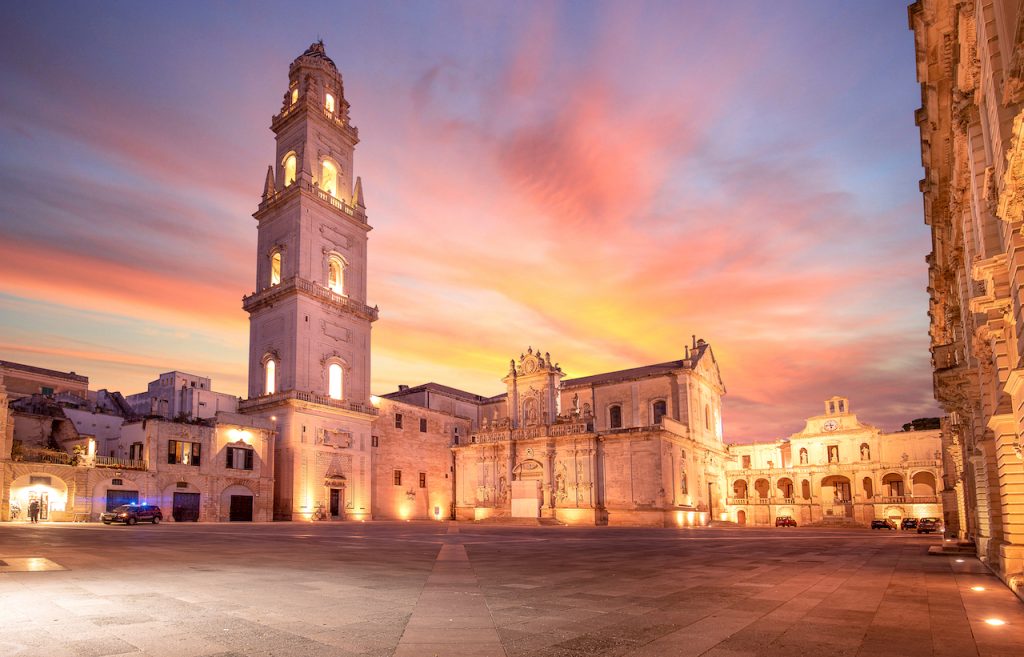
Lecce feels rather unique and can aptly be described as Puglia’s ‘Baroque jewel’. A good starting point for a visit to Lecce is the main piazza and cathedral. The cathedral is nestled in the corner of the Piazza del Duomo. The Duomo was built in 1144 but the 70 metre high bell tower was added later in the mid 17th century and is the work of Giuseppe Zimbalo, a talented architect who also worked on many of the other buildings of Lecce’s Baroque period. Also worth a visit in Lecce is the Basilica di Santa Croce whose facade is probably the most intricate Baroque façade anywhere in Italy. This was actually in part the work of Zimbolo’s grandfather!
Wander around Lecce’s streets during the day in the height of the Summer and you may find them quite deserted (the people of Lecce love their daily siesta which takes place from 2 pm to 5 pm each day). However, come 5 o’ clock, it is a very different story. The shutters are opened and behind them are a host of independent stores, hip bars and restaurants. Don’t miss the chance to sit and enjoy one of the city’s speciality coffees – caffe in ghiaccio con latte di mandorla (espresso with ice and almond milk). Or grab a table in one of the many restaurants to savour the peasant style cuisine and deep red wine that is typical of the area.
There is a wealth of other things to see and do in Lecce besides the cathedral and its history certainly goes much further back than the 16th century period of Spanish rule under which the Baroque architecture flourished. History lovers will enjoy the opportunity to discover the Roman amphitheatre which is situated in the Piazza Sant’ Oronzo. Whilst it can’t hold the 20,000 people that it once did in its heyday, if you’re lucky, you will still able to enjoy a concert here.
Looking for somewhere to stay? Discover our full collection of Puglia villas here.
Locorotondo
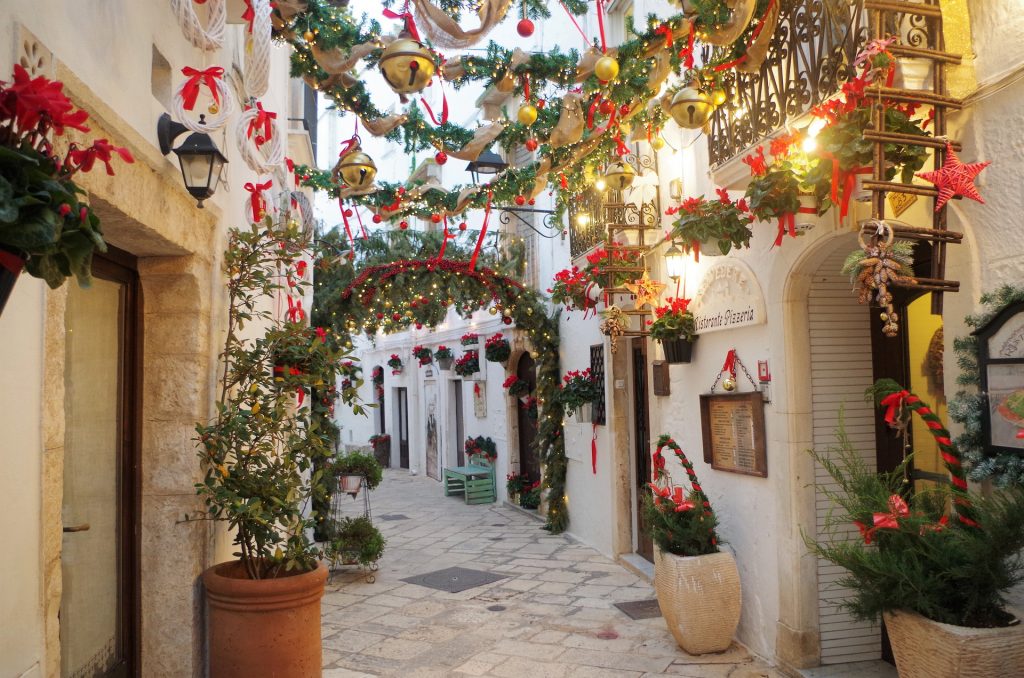
Taking its name from the town’s circular plan, Locorotondo is dominated by cummerse, the ancient buildings with slanted roofs. The whitewashed walls of the houses contrast with the baskets and tubs of flowers that festoon the walls.
The village is amongst the most beautiful in Italy and features in the list of the ‘borghi piu belli d’Italia’. It is also often referred to as the ‘balcony of the Valle d’Itria’ and it’s not hard to see why. The town is perched on top of a hill and enjoys magnificent views of the valley below, dotted with a patchwork of fields, vineyards and olive groves and interspersed with trulli and dry stone walls.
Whilst the town is home to some lovely churches as you can expect to find in most towns and cities in Italy (including the Church of the Madonna della Greca, the Church of San Rocco and the Church of San Girgio), this is really a town to simply spend time to wander around in, exploring the maze of streets.
As with all towns in Puglia, if exploring in the height of the Summer, it’s worth visiting during late afternoon or early evening time when the town starts to come to life. Or head to the town during July and August and you can enjoy the Locus music festival, during which you can enjoy a number of excellent jazz events that are taking place. Or, even better, on 16 August, join in the celebrations to mark Locorotondo’s patron saint – Rocco – which culminates in a grand firework display at midnight.
Manduria
Probably most famous these days for it’s wine production, it’s not surprising perhaps that Manduria is home to a Museum dedicated to the drink. The Museo della civilta del Primitivo has a host of interesting objects from the last 200 years all connected with wine production.
But there is more to the town than just it’s wine. Take the time to stroll downtown passing by buildings in the Baroque, Liberty and Neoclassical styles, to the Chiesa Matrice SS. Trinita, the Madonna del Rosario and the Jewish Ghetto of the 1600s.
Manduria is also home to the Archaeological Park of Manduria, one of the most important sites in Italy. Here you’ll find the Fonte Pliniano at the entrance, a place mentioned in Pliny the Elder’s ‘Historia Naturalis’. It’s a huge cave inside which sits a water spring. There is also a wonderful necropolis with more than 2000 messapic tombs dating back to the 6th to 2nd centuries BC.
Martina Franca
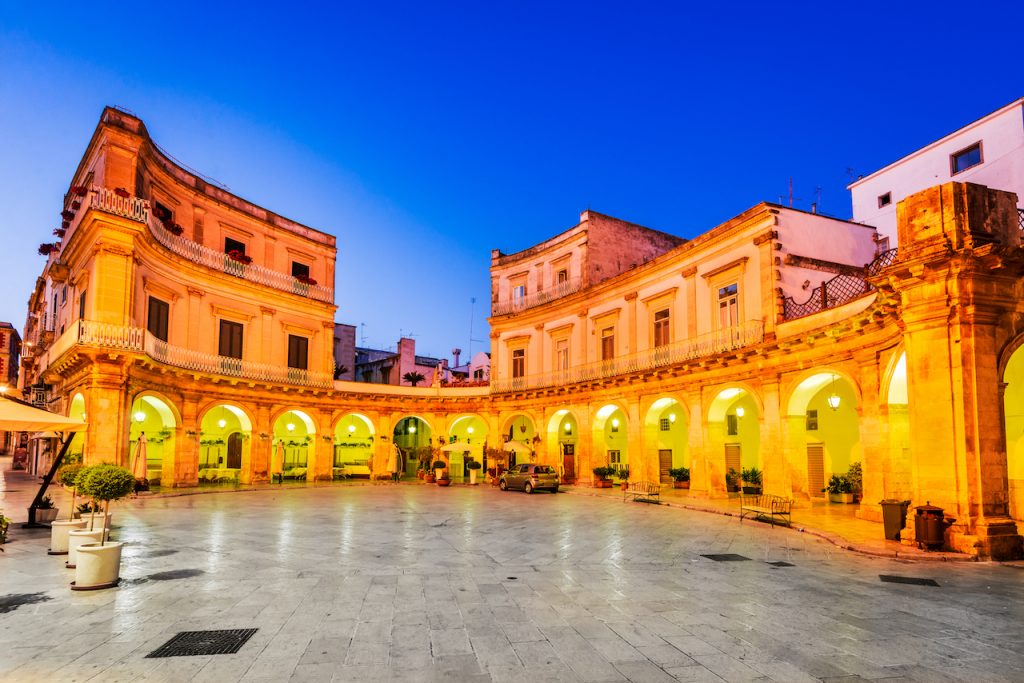
Martina Franca is the largest town in the Valle d’Itria and is an example of typical Baroque architecture. Mansions with wrought iron balconies, churches, elegant arches and monuments abound and every corner is filled with examples of art and architecture. Certainly the most famous example of these is the Palazzo Ducale, situated in which today is the home of the city hall. Designed by Caracciolo, and with a typical Baroque facade, it contains 300 rooms, a theatre, chapel and stables.
From here it’s a short walk to Piazza Plebiscito, which is the heart of the town and also the backdrop to the Basilica di San Martino.
The town is host to the Festival della Valle d’Itria each Summer when visitors will have the chance to enjoy numerous operatic performances. If you’re visiting from mid July to early August, you will be treated to a plethora of unseen operas, concerts, films and music. Head to the official website for more details about what’s on.
Make sure you try some of the town’s famous cured ham – capocollo – before you leave. Created by marinating pork in ‘cooked wine’, flavouring it with herbs, then stuffing it into natural casings where it is left for around 2 weeks and then smoked and left to age for 3 months, it’s absolutely delicious!
This stylish 4 bedroom villa in Puglia is situated close to Martina Franca.
Molfetta
Molfetta is a fishing centre and, not surprisingly, is therefore a good place to head if you’re looking to enjoy some excellent seafood, particularly in September when it plays host to the Festa del Mare (Sea Festival). Back in the day, it was a port that could rival that of Venice or Alexandria. These days, it’s a vibrant, friendly town. Many visit to enjoy a day at the Miragica Park which is the only amusement park in the South of Italy. However, it is also offers much of historic interest. The Medieval town is crammed with churches and Medieval monuments, one of the most famous of which is the cathedral dedicated to San Corrado. Built near the shoreline in a Romanesque style, this building has two tall towers on either side and is topped with three cupolas. This is not the oldest church in Molfetta though. This is, in fact, the Basilica of the Madonna of the Martyrs which contains a sculpture of the Holy Sepulchre that was carved from stone from the Holy Land.
Monopoli
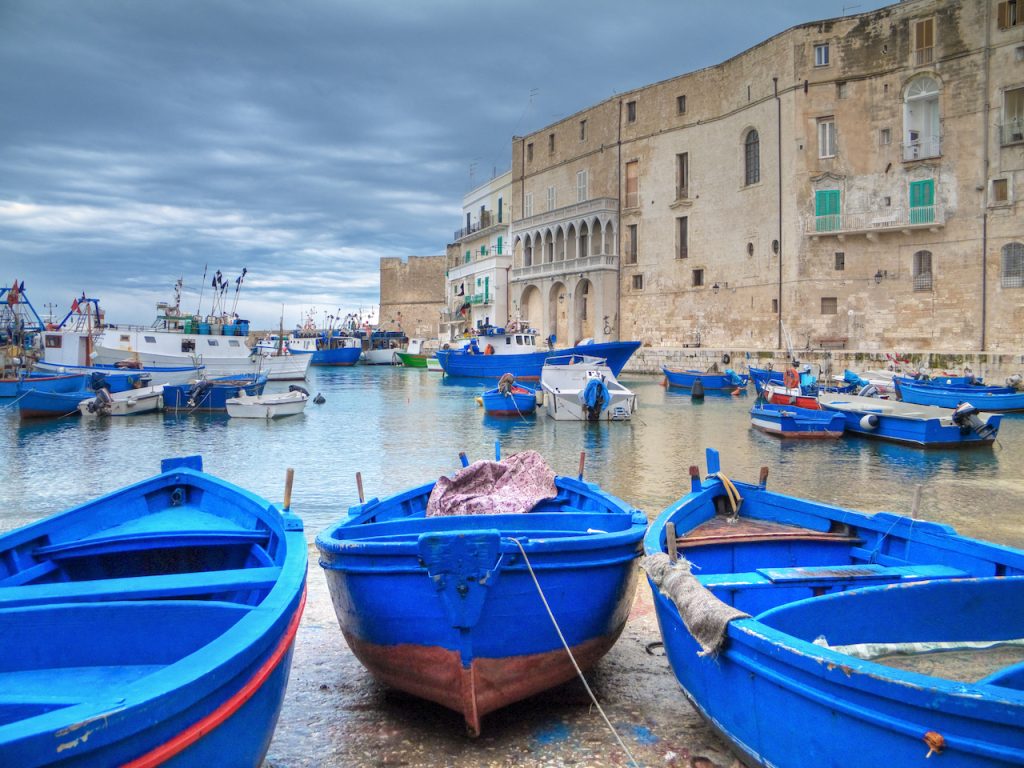
Monopoli is well worth a day trip. Make a point of visiting the 17th century cathedral and its impressive bell tower which, at over 60 metres tall, dominates the town below. The cathedral is dedicated to the Madonna della Madia, who, legend has it, arrived in Monopoli by boat in 1117, bringing with her 31 wooden beams for the roof supports of the basilica. Inside, take a look at the frescoes depicting Matthew, Mark, Luke and John.
Also of note in Monopoli’s Old Town is the castle. Built in 1552 by the Spanish, the octagonal castle was at that time separated from the rest of the city but, over the years, the city has built out to meet it. The castle still stands today and visitors can enjoy a visit. Take the time to head to the top as the views from here are incredible.
Finally, take a stroll through the old town down to the beach and along to the port with its series of little harbours where you can watch the fisherman bringing in their catch of their day or mending their nets. Instagram fans can take a stunning photo at the Porto Vecchio, capturing the picture perfect bright blue fishing boats which provide a striking contrast against the whitewashed walls of the harbour. Or just enjoy some time on Monopoli’s sandy beaches which are lovely.
This apartment in Monopoli is within walking distance of the beaches, shops and restaurants.
Nardo
Nardo has a real charm about it. Like much of Puglia it has a long and rich history but an earthquake in 1743 destroyed many of the buildings and so it was largely rebuilt in the 18th century in the ornate and beautiful Baroque Leccesse style. Some of the most impressive buildings from an earlier period that did survive include the 15th century Aragonese Castle of Nardo, the Palazzo Salandra of the Pretura and the San Domenica Church. We recommend visiting the Piazza Salandra at night when it’s mix of Baroque and Rococo styles are beautifully lit.
Nardo is also famous for its stunning coastline and for the ‘Nardo ring’, a 12.5 test track used for speed testing with four lanes for cars and motorbikes as well as an inner ring for larger trucks and lorries.
Noci
This is a food lovers paradise, especially if you are a fan of dairy foods. Noci is renowned for its production of mozzarella, burrata and stracciatelle. Not surprisingly, the town goes out of its way to celebrate this rich history of food production, hosting two festivals – the Bacco nelle Gnostre (festival of wine and chestnuts) in November and the Pettole nelle Gnostre and Cioccolato in Sagra in December.
Ostuni
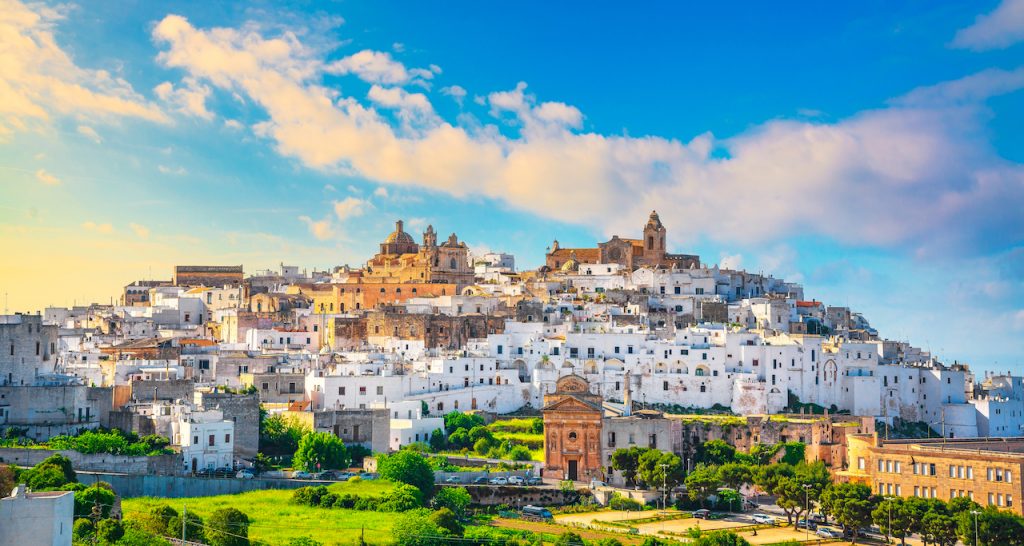
Known affectionately as ‘The White City’, visitors will spot the striking hilltop town from quite a distance away thanks to its white-washed houses. With hindsight, it is actually believed that the lime paint which has been used to paint the buildings white for centuries may, in fact, have saved many local residents from the plague thanks to the paint’s natural disinfectant properties.
Take time to explore all of Ostuni’s narrow streets, staircases and passageways, lined with houses, shops, restaurants and cafes. It’s easy to explore on foot but for those looking to explore in a more creative way, it’s possible to take a tour by tuk tuk or even via segway. We’re definitely firm advocates of taking the time to meander through the streets on foot though if you want to fully absorb the atmosphere and your surroundings. For one thing, many of the streets are simply too narrow to explore by any other means. But take care not to get lost…. The web of streets is a very confusing maze which would certainly have muddled up many invaders over the centuries, among them the Greeks, Romans, Normans and Byzantine. Ostuni is definitely a real labyrinth!
One building you definitely won’t be able to miss because of its sheer size is the city’s cathedral. Dedicated to the Assumption of the Virgin Mary, this was constructed in the 15th century. Its late Gothic-Romanesque-Byzantine style differs from much of the rest of the architecture in Puglia which tends to be Baroque or Romanesque. Take the time to admire its magnificent frilly rose window which has Jesus at its centre surrounded by 24 ornately carved columns representing each of the hours of the day. And step inside to marvel at the 18th century art that adorns the ceiling.
The city really comes to life in the evening, with a vibrant nightlife and plenty of hip bars and restaurants so it is definitely worth planning your visit so that you get to experience the town at night. It’s also a great place to visit during the Summer when it plays host to numerous festivals, many of which have food or wine at their centre. Some of the most well-known of these are the Processione della Grata on 2 August which culminates in a spectacular evening of candelight when the candles of the 6000 or so people attending will light up the countryside. Also in August is the Sagra dei Vecchi Tempi, held on 15 August each year. At this event, visitors will have the opportunity to try traditional culinary dishes from the local area. Finally, towards the end of the month, there is the Cavalcata di Sant’ Oronzo which will leave visitors imagining that they have stepped back into Medieval times as they enjoy an impressive parade of knights on horseback.
Trulli Nicoletta is a contemporary villa in Ostuni, just a short distance from the heart of the city.
Otranto
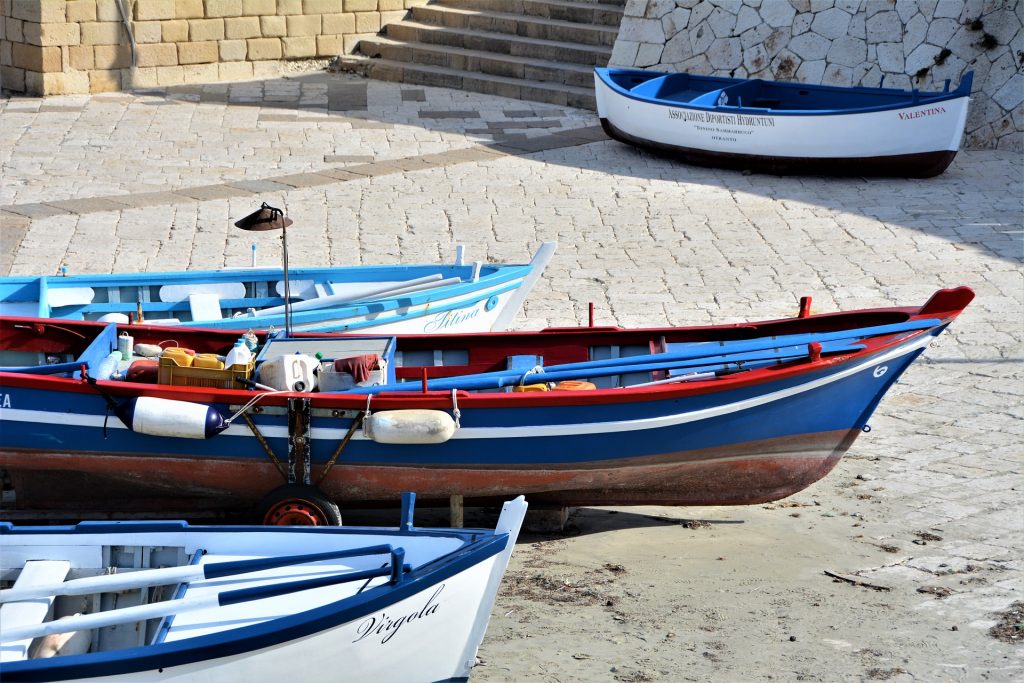
Italy’s easternmost city, Otranto is a stunning seaside city that is not to be missed. Its historic centre is beautiful, epitomized by alleys full of flowers and with panoramic views around many a corner across the sea towards the Balkans and Greece. If you’re looking to enjoy a slower pace of life, then Otranto can also boast some excellent sandy beaches and some beautiful sea front promenades. Head just South of Otranto to the Capo d’Otranto where you can enjoy a wonderful walk enjoying coastal views, unspoilt scenery and a glimpse of the lighthouse that protects sailors from the rocky cliffs.
Also just outside Otranto but in the other direction is I Laghi Alimini. These connected lakes are a paradise for wildlife with a number of species of birds including flamingoes and both black and white herons.
In Otranto itself, don’t miss the Castello Aragonese, the Basilica di San Pietro and the Cattedrale dell’ Annunziata. The latter is a Romanesque cathedral dating back to 1088 and home to the incredible 12th century mosaic floor that depicts the tree of life.
Peschici
Perched on the cliffs above the sea, Peschici is a charming fishing village, epitomized by narrow streets, stairways carved into the hillside and white-washed houses overlooking a picturesque bay. What you may not be expecting to find in the town is a Museum of Torture, located in the Norman castle in the town.
Widely known as ‘the Pearl of the Gargano’, Peschici boasts some wonderful sandy beaches. but don’t miss the chance to leave the beach to visit the town centre too. It is very popular with tourists but despite this has retained its charm and authenticity. Explore the narrow streets that lead to the castle at the top of the town.
Polignano a Mare
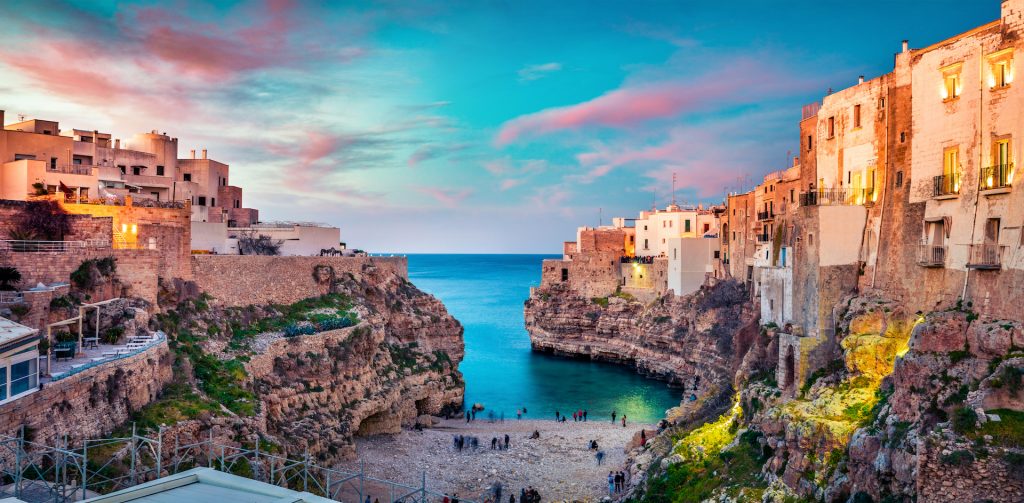
Like many of the towns in Puglia, Polignano a Mare has a rich and varied history. It’s origins date back to the Greeks of the 4th century BC but it then flourished under the Romans as well.
As you pass through the Porta Vecchia, you enter the charming old town, with its whitewashed streets so typical of this region. Just take your time to stroll through its narrow streets, popping into some of the many small shops that line the way. Whichever way you take, you’re bound to eventually reach one of the three panoramic terraces that the town can boast. All three afford beautiful views of the Adriatic Sea and glimpses of the buildings perched on the cliff tops.
The town has played host to the annual cliff diving championships for a number of years. Attracting crowds of around 50,000 people each year, this is an incredible spectacle. Whether or not you are timing your visit to coincide with this sporting event, it’s definitely worth the short walk from the town centre to Polignano a Mare’s Blue Flag beach that nestles between two steep cliffs. You’ll find teenagers jump and dive off these cliffs all day long into the turquoise sea below.
There is plenty to keep you entertained in Polignano a Mare in the Winter months too, particularly in the run up to Christmas. For the three weeks prior to Christmas Day, Puglia is transformed into a winter wonderland, with huge Christmas tree in the main piazza – the Piazza Vittorio Emanuele – along with a Christmas market and the largest Santa’s grotto in Puglia.
In 2018 the town council started to erect turnstiles at the entrance to the town at key times of year including during December, charging tourists a nominal fee to enter. But don’t let this put you off.
Porto Cesareo
Famous for its 17 kilometres of wonderful golden beaches and beautiful coastline, Porto Cesareo is a small fishing village set within the Palude del Conte e Duna Costiera nature reserve. Head underwater off the coast of the village and you will enjoy the opportunity to explore some incredible coral formations as well as turtles and sea horses.
Putignano
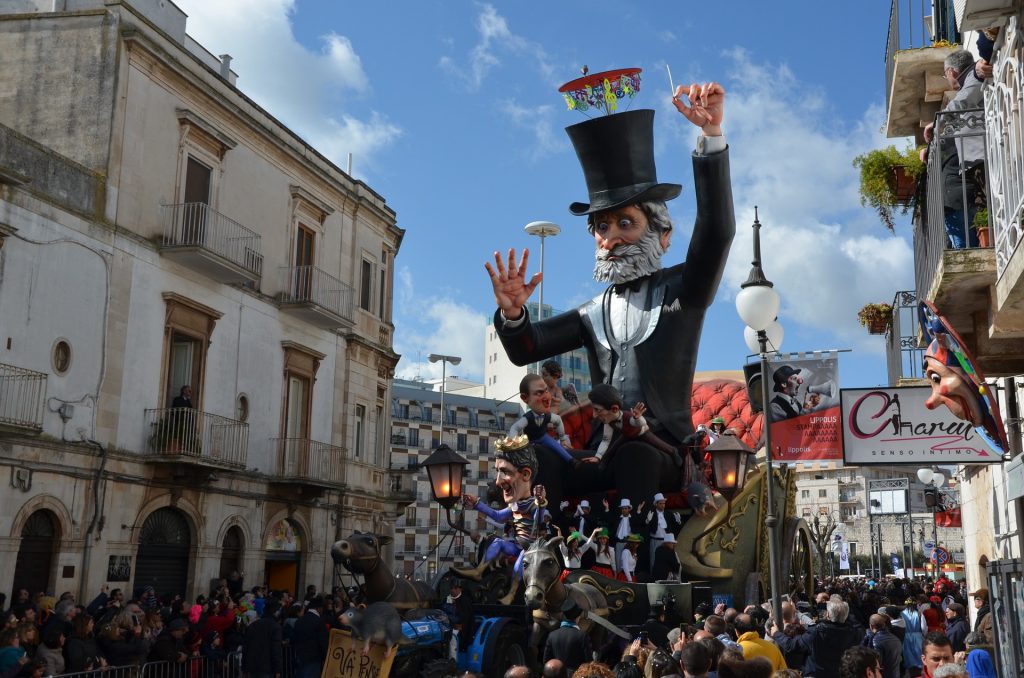
Putignano is the birthplace of Europe’s oldest and longest carnival, taking place from the 26 December to Shrove Tuesday each year. Legend has it that the carnival started back in 1394 when people celebrated the fact that the relics of St Stefan had successfully been brought to Putignano from Monopoli for safe keeping. Nowadays the carnival is filled with giant floats, papier mache masks and nighttime parades through the town’s narrow streets and courtyards. The mascot of the carnival is known as Farinella. Dressed as a jester, he carries out plenty of practical jokes to keep spectactors amused. Putignano then hosts another smaller Summer carnival each July.
While you are in Putignano, also take time to visit the Palazzo del Bali, the church dedicated to St Peter the aspostle, the 14th century Church of Santa Maria la Greca and the Church of San Domenico.
Not far from the town is the Grotta del Trullo. Discovered in the 1930s, this was the first cave in Puglia to be opened to the public. A spiral staircase takes visitors several metres underground to explore the cave with its myriad of stalactites and stalagmites.
Santa Maria al Bagno
Santa Maria al Bagno is a small fishing village with only about 1000 inhabitants. During WWII, it was also the site of a displaced person camp and a museum in the village – the Museum of Memory and Welcome – is now dedicated to the thousands of concentration camp survivors who made their way through Italy to get to Israel in the four years between 1943 and 1947.
Santa Maria di Leuca
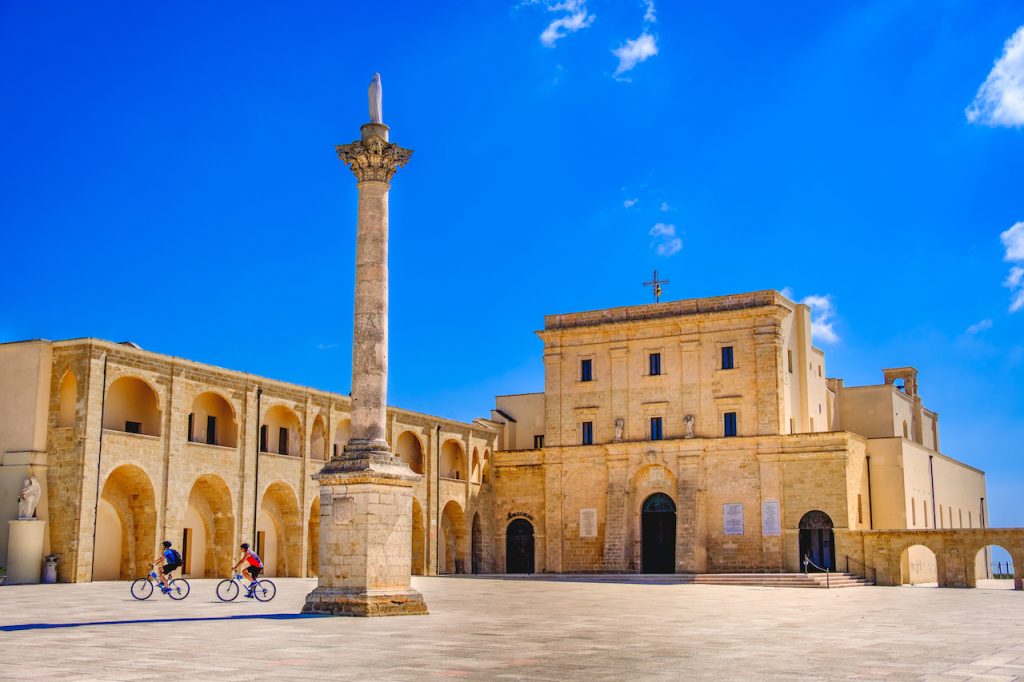
A seaside town sitting on the southernmost tip of the Salento peninsula, Santa Maria di Leuca is a real mix of architectural styles, with the Moorish, liberty, gothic and Arabic styles all competing for attention.
Arguably its most impressive building is its lighthouse. Built in 1864, its octagonal design is 47 metres high and has 254 steps from the ground floor to the top. But also worth seeing is a very different architectural gem – a man-made waterfall commissioned by Mussolini to mark the end of the Puglia aqueduct. The Italian dictator even moved a Roman column from it’s original position in Rome to the base of the waterfall. Unfortunately, you need to be lucky to catch the waterfall in action though as it’s only opened a handful of times each year.
The history of Santa Maria di Leuca is a long and varied one. Documents even attest to St Peter stopping there on his way to Rome, whilst the Basilica de Finibus Terre was built on a site that was once home to a Temple of Minerva. Legend has it that this temple crumbled to the ground as St Peter passed through.
The sanctuary has long been a popular place for pilgrims to visit, many of whom choose to visit in mid August when the Statue of the Virgin Mary is collected from the sanctuary and taken to the Church of Cristo Re for the night. On the 15th August, the statue is then paraded through the streets before being placed on board a fishing boat in the port. This boat makes its ways across to the Port of San Gregorio and back, accompanied all the while by a flotilla of other vessels and well-wishers. Once back, the statue is safely returned to it’s normal resting place in the sanctuary and the celebrations begin in style with fireworks and partying through the night.
More recently, Santa Maria di Leuca has been a popular resort amongst wealthy Puglians since the early 1900s hence the existence of numerous eye catching Art Nouveau villas that line the sea front. Certainly people flock here because of it’s wonderful white sandy beaches. Some of the best include nearby Felloniche, Posto Vecchio, Torre Vado and Pescoluse. All are family friendly and equipped with lidos, bars, restaurants and other facilities.
Some of the real gems here must be discovered by boat though. Head off shore to discover the many caves that dot this coastline including the Grotta Porcinara and Grotta del Diavolo. In total there are around 30 caves altogether. But don’t worry, there is no shortage of sailors and boats keen to take you out to explore all that the coastline has to offer.
Savelletri
Savelletri is a tiny fishing village with a picturesque harbor and with a host of restaurants set overlooking the sea. It is famed for its quality seafood made famous worldwide by renowned British chef, Rick Stein.
Visit on the second Sunday of August and you can join in the celebrations to mark the feast day of San Francesca da Paola, which involve a procession of boats and a food festival where swordfish is the food of choice.
Also nearby is the Parco Archeologico di Egnazia, arguably one of the most important sites in Italy with ruins dating back as far as the Bronze Age as well as Roman remains from the 3rd century BC.
Specchia
Specchia deserves its position in the list of the Borghi piu belli d’Italia. In its centre of the town is the Piazza del Popolo which has the Castello Risolo on one side and the Chiesa Madre on the other. The town is also an important centre for olive oil production. It’s worth booking a tour of the underground oil presses in Specchia to learn more about this important aspect of the local economy.
Taranto
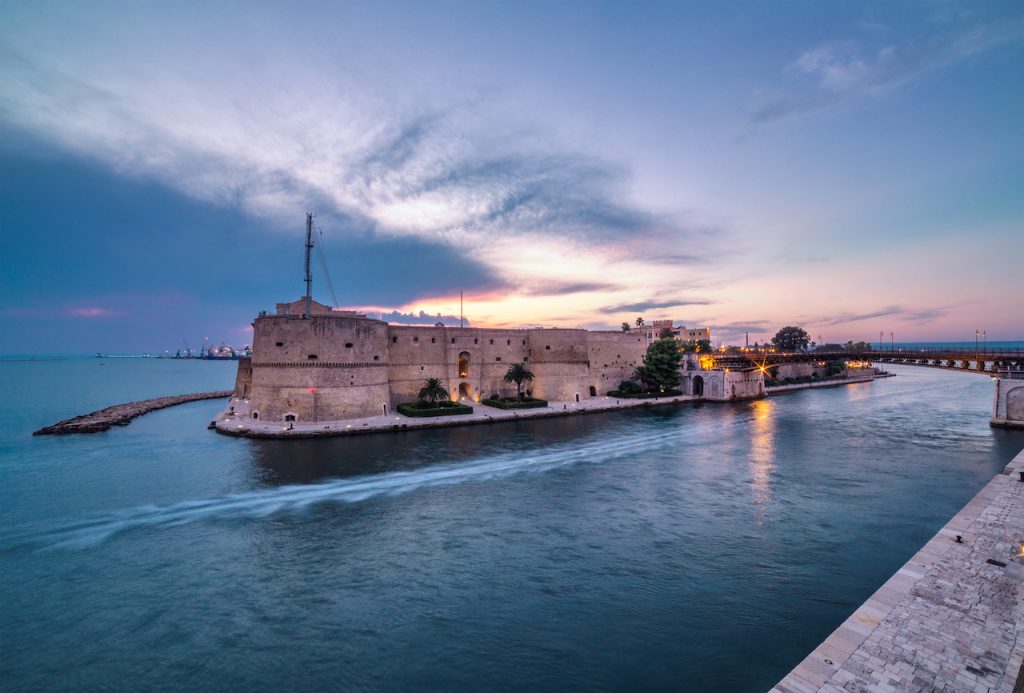
Taranto has received mix press over the past few years, certainly from a tourist perspective. First and foremost, it is a huge commercial and military port. Commercial shipping and trade, steel works and iron foundries are all industries that have flourished here over the years. Driving towards the city, you will see the belching oil refineries and large factories and many will see this and be put off immediately.
That said, there is still plenty for the holidaymaker to enjoy especially as Taranto has had such a long and rich past. Anything that you will want to explore will be in Taranto’s old town – the ‘Borgo Antico.’ One of the most beautiful sights here is certainly the Castello Aragonese, the majority of which dates back to the 15th century. Visitors can go inside and enjoy the views across the sea from its towers. Also inside is the Chapel of St Leonard which is also worth seeing. Nearby is the Temple of Poseidon, the remains of a 6th century BC temple. The Borgo Antico is connected to the modern part of the city by the Ponte Girevole which is of interest itself.
Taranto also boasts some interesting museums including the National Archaeological Museum which covers the history of the many cultures that have played a role in Taranto’s past and the Spartan museum where you can discover the history of the Spartans in the museum.
Torre Guaceto
Situated just a few kilometres from Brindisi is Torre Guaceto, an 8 km stretch of coastline. A Marine Protected Area, it is a beautiful nature reserve, with crystal clear waters in which you will easily spot a massive variety of wildlife.
Trani
Trani is a historic fishing port, a sleepy town typical of many of the towns and villages along this stretch of coastline. Of note is the Castello Svevo, a fortress built by the Holy Roman Emperor Frederick II in the mid 13th century. It was used as a prison until the 1970s but is noe open to visitors. Near to this is the Cattedrale di San Nicola Pelligrino (the Cathedral of St Nicholas the Pilgrim) which also stands at the shore and contains the remains of a 12th century mosaic depicting Alexander the Great as well as Adam and Eve. The building is set over several levels. Beneath the main church is an older one dedicated to Santa Maria della Scala and below that is an older 6th century chamber.
Vieste
Vieste is a small coastal town on the Gargano peninsula in the north of Puglia. It sits atop white cliffs that jut into the sea and is framed by beautiful sandy beaches on either side. The town is picturesque, characterised by whitewashed houses, narrow alleyways and steep steps and staircases. It’s worth taking a walk around the perimeter of the town from the town’s Norman castle to the Church at Punta San Francesco to admire the stunning sea views that it boasts.
Marina Piccola and the Spaggia del Castello. Both are very popular with tourists in the Summer months and, if you like kite surfing or scuba diving, these are great bases to choose. As with Peschici, it’s worth exploring the labyrinth of winding streets, filled with boutiques and shops selling local ceramics and crafts.
Where to stay in Puglia’s Towns and Villages
Here at Bookings For You we have decades of experience in planning holiday to Italy. Puglia is a real gem and we have some absolutely stunning villas and apartments for your to choose from. Discover the full collection here or contact us to help you find your perfect place for your next trip to Italy.




